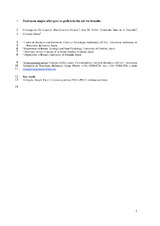Parietaria major allergens vs pollen in the air we breathe
Autor
Linares, Concepción De
Alcázar, Purificación
Valle, Ana M.
Díaz de la Guardia, Consuelo
Galán, Carmen
Editor
ElsevierFecha
2019Materia
Par j 1-Par j 2 allergensUrticaceae pollen
Biological air quality
ELISA analysis
METS:
Mostrar el registro METSPREMIS:
Mostrar el registro PREMISMetadatos
Mostrar el registro completo del ítemResumen
Background
Parietaria and Urtica are the genera from the Urticaceae family more frequent in Mediterranean and Atlantic areas. Moreover, both genera share pollination periods, and their pollen (of the main species) is so similar that there is no aerobiological evidence of the proportion of each of them in the airborne pollen identification, except in the case of U. membranacea. However, Parietaria is one of the most important causes of pollinosis and Urtica is not. Our aim is determine if airborne Urticaceae pollen concentrations show the aerodynamics of the two major allergens of Parietaria (Par j 1 and Par j 2) as well as the allergen distribution in the different-sized particles.
Methods
The air was sampled during the pollination period of Urticaceae using Hirst Volumetric Sampler and Andersen Cascade Impactor in two cities of Southern Spain (Córdoba and Granada). The samples were analysed by the methodology proposed by the Spanish Aerobiology Network (REA) and the minimum requirements of the European Aeroallergen Society (EAS) for pollen, and by ELISA immunoassay for allergens.
Results
The patterns of airborne pollen and Par j 1-Par j 2 were present in the air during the studied period, although with irregular oscillations. Urticaceae pollen and Par j 1-Par j 2 allergens located in PM2.5 showed positive and significant correlation during the period with maximum concentrations (March to April).
Conclusion
Parietaria aeroallergens show similar pattern of Urticaceae airborne pollen. Urticaceae pollen calendar is as a good tool for allergy prevention. On the other hand, important concentrations of Par j 1 and Par j 2 were located in the breathable fraction (PM2.5), which could explain the asthmatic symptoms in the allergic population to Parietaria.

